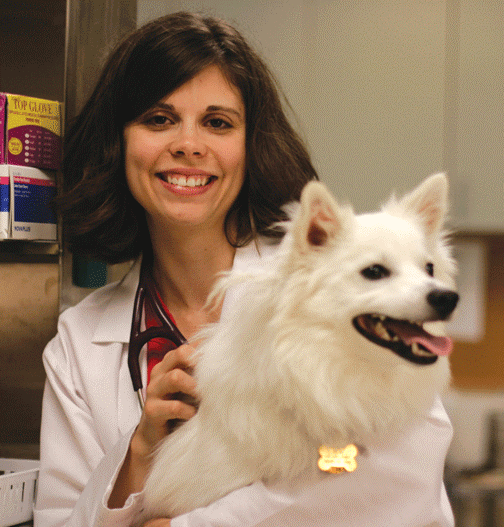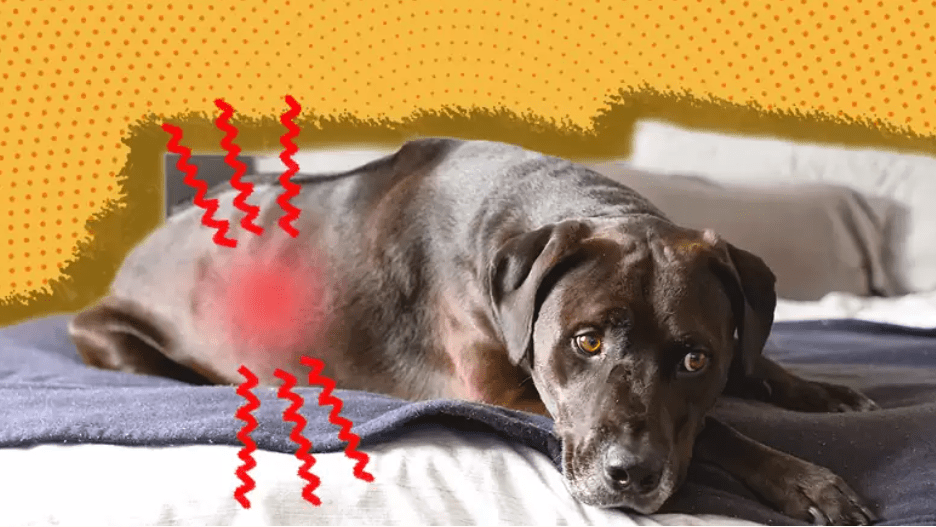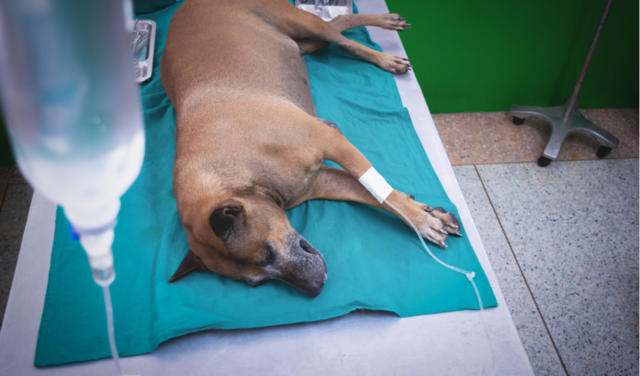-
Adopt
-
Veterinary Care
Services
Client Information
- What to Expect – Angell Boston
- Client Rights and Responsibilities
- Payments / Financial Assistance
- Pharmacy
- Client Policies
- Our Doctors
- Grief Support / Counseling
- Directions and Parking
- Helpful “How-to” Pet Care
Online Payments
Emergency: Boston
Emergency: Waltham
Poison Control Hotline
-
Programs & Resources
- Careers
-
Donate Now
 By Shawn Kearns, DVM, DACVIM-SA
By Shawn Kearns, DVM, DACVIM-SA
![]() angell.org/internalmedicine
angell.org/internalmedicine
internalmedicine@angell.org
617-541-5186
May 2023
x
x
Several types of familial and congenital renal diseases are reported in dogs. Diseases categories include renal dysplasia, glomerulopathies, polycystic kidney disease, and with tubular defects. Patients can initially present anywhere from a few weeks to several years old. Clinical signs may be absent or mild at initial evaluation, or changes in lab work may be found incidentally. Otherwise, clinical signs are often related to kidney dysfunction, including polyuria, polydipsia, decreased appetite, vomiting, and decreased body condition. The disease progression rate is often variable, though with some specific diseases noted below, the progression may be very quick and result in a significantly shortened life span. Diagnosis is often made based on age when azotemia is first noted, imaging findings, and if there is a known breed association. However, it is important to remember that many cases likely go unreported so all breed associations are likely unknown. Ultrasound may be unremarkable, but changes that may be noted include small irregular kidneys (uni or bilateral), decreased corticomedullary definition, hyperechoic speckling in the renal medulla, and a generalized increase in medullary echogenicity. Histopathology, including sometimes electron microscopy, is needed for a definitive diagnosis of many of the below forms of renal disease. However, this is often not pursued as management for most patients is the same as for patients who develop chronic kidney disease later in life.
or mild at initial evaluation, or changes in lab work may be found incidentally. Otherwise, clinical signs are often related to kidney dysfunction, including polyuria, polydipsia, decreased appetite, vomiting, and decreased body condition. The disease progression rate is often variable, though with some specific diseases noted below, the progression may be very quick and result in a significantly shortened life span. Diagnosis is often made based on age when azotemia is first noted, imaging findings, and if there is a known breed association. However, it is important to remember that many cases likely go unreported so all breed associations are likely unknown. Ultrasound may be unremarkable, but changes that may be noted include small irregular kidneys (uni or bilateral), decreased corticomedullary definition, hyperechoic speckling in the renal medulla, and a generalized increase in medullary echogenicity. Histopathology, including sometimes electron microscopy, is needed for a definitive diagnosis of many of the below forms of renal disease. However, this is often not pursued as management for most patients is the same as for patients who develop chronic kidney disease later in life.
Renal dysplasia (RD) is a hereditary disease characterized by abnormal differentiation and disorganized development of renal parenchyma. In most cases, the exact mode of inheritance or genetic mutation is unknown. A wedge biopsy is necessary as a minimum of 100 glomeruli must be assessed for a definitive diagnosis.1 A recent study2 evaluated the potential role of cyclooxygenase-2 (COX-2) in RD. Although COX-2 is typically associated with pathologic events, studies cited in this article suggest that COX-2 has an important role in in-utero kidney development. In this study, mutant alleles of COX-2 were found to have a 100% correlation with clinical cases of RD.2 Breeds with the highest incidence of RD had the highest frequency of mutant alleles. Immature or fetal glomeruli remain present in the kidney past six months of age, and the higher the percentage of fetal glomeruli, the more severe changes in other kidney tissue.3 Over time, secondary degenerative and inflammatory changes occur. Renal dysplasia has been best characterized in the Shih Tzu and Lhasa apsos.3,4,5 Still, it is reported in many other breeds of dogs, including but not limited to Golden Retrievers,6 Dutch Kooiker dogs,7 Boxers,8 and Beagles.9 Renal dysplasia has been reported concurrently with other urogenital abnormalities, including unilateral renal agenesis10 and ureteral ectopia.11
Amyloidosis is characterized by the extracellular deposition of insoluble fibrillary proteins with a specific beta-pleated sheet conformation. The hereditary form is caused by abnormal genes encoding variant proteins whose structures make them amyloidogenic. Familial amyloidosis has been reported in the Chinese Shar-Pei (CSP), 12 Beagles,13 and English Foxhounds.14 Familial Chinese Shar-Pei fever, with recurrent fevers and swollen  hocks, predisposes to secondary (reactive) amyloidosis. Unlike most other breeds affected by amyloid, in CSPs, the lesions are primarily medullary and often have deposition in other organs. In non-CSPs, lesions are more commonly glomerular in location, and while both CSPs and non-CSPs have increased urine: protein to creatinine ratios, the presence of hypoalbuminemia and nephrotic syndrome is higher in non-CSP breeds (JVIM Retro shar/nonshar). Age at presentation is often younger (median six years) for CSPs, while non-CSP breeds can present later in life.15
hocks, predisposes to secondary (reactive) amyloidosis. Unlike most other breeds affected by amyloid, in CSPs, the lesions are primarily medullary and often have deposition in other organs. In non-CSPs, lesions are more commonly glomerular in location, and while both CSPs and non-CSPs have increased urine: protein to creatinine ratios, the presence of hypoalbuminemia and nephrotic syndrome is higher in non-CSP breeds (JVIM Retro shar/nonshar). Age at presentation is often younger (median six years) for CSPs, while non-CSP breeds can present later in life.15
Hereditary nephritis results from a genetic mutation leading to the abnormal formation of type IV collagen. Type IV collagen consists of heterotrimers of six possible peptide α- chains 1 to 6. Mutations cause improperly formed chains to be unable to interact with other chains. The faulty interaction leads to glomerular basement membrane splitting and thickening. The ultrastructural changes in the basement membrane alter glomerular permeability and selectivity, leading to the loss of larger molecules such as albumin. As with other causes of renal protein loss, the excess protein can damage renal tubular cells, cause mesangial proliferation, and obstruct tubules with protein casts.16 X-linked hereditary nephritis of Samoyeds has a nucleotide substitution in the COL4A5 gene causing abnormal alpha-5 chains. Proteinuria is the first indicator that can occur as early as three months of age in males, with progression to severe azotemia in one year. In females, the rate of progression is much slower, with azotemia apparent after a few years.17 English Cocker Spaniels have an autosomal recessive form of the disease, and both sexes are affected equally. Again proteinuria is detected at a few months of age, with azotemia developing in one to two years. An autosomal dominant mutation has been described in Bull Terriers and Dalmatian dogs, but the genetic mutation has not been fully characterized. Age of onset is variable from a few months of age up til seven to eight months.18 Electron microscopy is often needed to make a diagnosis for this class of renal disease.
Podocytopathies are another form of hereditary nephritis. In the normal slit diaphragm, numerous molecules interact and connect to the cytoskeleton of the podocyte foot processes. The interaction enables three-dimensional changes in the shape and size of the slit diaphragm but, when damaged, leads to protein loss and focal segmental glomerulosclerosis. A genetically linked podocytopathy is suspected in some breeds, including the soft-coated Wheaton Terrier18,19 and Airedale Terrier.20 Variant alleles (NPHS1 and KIRREL2) encoding the proteins of the immunoglobulin superfamily, nephrin, and Neph3/filtrin, which are part of the complex structure of the slit diaphragm have been identified in these breeds.18 In SCWT, the age of onset tends to be later (six years), and clinical signs often involve the intestinal tract and the signs of protein-losing nephropathy.
Polycystic kidney disease (PKD), a genetic disorder characterized by bilateral renal cysts of varying size and number within the cortex and medulla, has been primarily reported in Bull Terriers,21 Cairn Terriers,22 and West Highland White Terriers (WHWT).23 An autosomal dominant mode of inheritance of a genetic mutation of the polycystin-1 (PKD-1) gene has been found in Bull Terriers. In contrast, an autosomal recessive mode is suggested in the Cairn and WHWT. Decreased kidney function is noted in the first years of life in Bull Terriers, while an earlier onset (first months of life) is seen in Cairn and WHWT. Additionally, multiple cysts are noted in the latter breeds in the kidneys and liver. Though rarely reported in dogs, other cystic diseases of the kidney include medullary sponge kidney, where cysts arise in the medullary collecting ducts (Shih Tzu)24 and glomerulocystic kidney disease, where there is a cystic dilatation of > 5% of Bowman’s spaces (Belgian Malinois, Collie).25, 26
suggested in the Cairn and WHWT. Decreased kidney function is noted in the first years of life in Bull Terriers, while an earlier onset (first months of life) is seen in Cairn and WHWT. Additionally, multiple cysts are noted in the latter breeds in the kidneys and liver. Though rarely reported in dogs, other cystic diseases of the kidney include medullary sponge kidney, where cysts arise in the medullary collecting ducts (Shih Tzu)24 and glomerulocystic kidney disease, where there is a cystic dilatation of > 5% of Bowman’s spaces (Belgian Malinois, Collie).25, 26
Congenital tubular defects are uncommon in dogs but have been reported in isolation and conjunction with other hereditary or familial renal diseases.27 Tubular disorders include primary renal glycosuria, aminoaciduria, electrolyte disorders, proximal and distal tubular acidosis, and nephrogenic diabetes insipidus. The main feature of these diseases is the loss of various substances (glucose, water, amino acids) that typically the tubules would conserve. Congenital Fanconi syndrome with renal dysplasia was reported in Border Terriers,28 while the most recognized Fanconi syndrome is reported in Basenji.29 Diagnosis in this category of diseases is typically made through alterations in the biochemistry profile, blood gas analysis, and urine amino acid profiling. Additional treatments may be needed to help support acid-base balance.
In summary, though not encountered often, there are many types of congenital and familial renal diseases in dogs. Early identification is vital for management as progression is often variable between and within each type of renal disease. Ongoing research is needed to characterize further specific genetic or hereditary links for these early-onset renal diseases.
x
References
- Picut CA, Lewis RM: Microscopic features of canine renal dysplasia. Vet Pathol 1987 Vol 24 (2) pp. 156-63
- Whiteley MH, Bell JS, Rothman DA: Novel allelic variants in the canine cyclooxgenase-2 (Cox-2) promoter are associated with renal dysplasia in dogs. PLoS One 2011 Vol 6 (2) pp. e16684
- Hoppe A Swenson L, Jo¨nsson L Hedhammar A: Progressive nephropathy due to renal dysplasia in shih tzu dogs in Sweden: A clinical pathological and genetic study. J Small Anim Pract 1990. 31: 83–91
- O’Brien TD, Osborne CA, Yano BL, Barnes DM: Clinicopathologic
manifestations of progressive renal disease in Lhasa Apso and Shih Tzu dogs J Am Vet Med Assoc 1982 180: 658–64 - Bovee KC: ‘‘Renal Dysplasia in Shih Tzu Dogs’’. Proceedings of the 28th World Congress of the World Small Animal Veterinary Association 2003
- deMorais HS, DiBartola SP, Chew DJ: Juvenile renal disease in golden retrievers: 12 cases (1984-1994). J Am Vet Med Assoc 1996 Vol 209 (4) pp. 792-7
- Schulze C, Meyer HP, Blok AL, et al: Renal dysplasia in three young adult Dutch kooiker dogs. Vet Q 1998 Vol 20 (4) pp. 146-8
- Hoppe A, Karlstam E: Renal dysplasia in boxers and Finnish harriers. J Small Anim Pract 2000 Vol 41 (9) pp. 422-6
- Bruder MC, Shoieb AM, Shirai N, et al: Renal dysplasia in Beagle dogs: four cases. Toxicol Pathol 2010 Vol 38 (7) pp. 1051-7
- Morita T, Michimae Y, Sawada M, et al: Renal dysplasia with unilateral renal agenesis in a dog. J Comp Pathol 2005 Vol 133 (1) pp. 64-7
- Yoon HY, Mann FA, Punke JP, et al: Bilateral ureteral ectopia with renal dysplasia and urolithiasis in a dog. J Am Anim Hosp Assoc 2010 Vol 46 (3) pp. 209-14
- DiBartola SP, Tarr MJ, Webb DM, et al: Familial renal amyloidosis in Chinese Shar Pei dogs. J Am Vet Med Assoc 1990 Vol 197 (4) pp. 483-7
- Bowles MH, Mosier DA: Renal amyloidosis in a family of beagles . J Am Vet Med Assoc 1992 Vol 201 (4) pp. 569-74
- Mason NJ, Day MJ: Renal amyloidosis in related English foxhounds. J Small Anim Pract 1996 Vol 37 (6) pp. 255-60
- Segev G, Cowgill LD, Jessen S, et al: Renal amyloidosis in dogs: a retrospective study of 91 cases with comparison of the disease between Shar-Pei and non-Shar-Pei dogs. J Vet Intern Med 2012 Vol 26 (2) pp. 259-68
- Thorner PS, Zheng K, Kalluri R, et al: Coordinate gene expression of the alpha3, alpha4, and alpha5 chains of collagen type IV. Evidence from a canine model of X-linked nephritis with a COL4A5 gene mutation. J Biol Chem 1996 Vol 271 (23) pp. 13821-28
- Jansen B, Valli VE, Thorner P, et al : Samoyed hereditary glomerulopathy: serial, clinical and laboratory (urine, serum biochemistry and hematology) studies. Can J Vet Res 1987 Vol 51 (3) pp. 387-93
- Littman MP: Emerging perspectives on hereditary glomerulopathies in canines. Adv Genomics Genet 2015 Vol 5 (0) pp. 179-88
- Littman MP, Wiley CA, Raducha MG, Henthorn PS. Glomerulopathy and mutations in NPHS1 and KIRREL2 in soft-coated Wheaten Terrier dogs. Mamm Genome. 2013; 24: 119- 126
- Littman MP, Raducha MG, Henthorn PS. Prevalence of variant alleles associated with protein-losing nephropathy in Airedale Terriers. J Vet Intern Med. 2014; 28: 1366- 1367
- Gharahkhani P, O’Leary CA, Kyaw-Tanner M, et al: A non-synonymous mutation in the canine Pkd1 gene is associated with autosomal dominant polycystic kidney disease in Bull Terriers. PLoS One 2011 Vol 6 (7) pp. e22455
- McAloose D, Casal M, Patterson DF, et al: Polycystic kidney and liver disease in two related West Highland White Terrier litters. Vet Pathol 1998 Vol 35 (1) pp. 77-81
- McKenna SC: Polycystic disease of the kidney and liver in the Cairn Terrier. Vet Pathol 1980 Vol 17 (4) pp. 436-42
- Akihara Y, Shimoyama, K, Ohya, A et al: Medullary sponge kidney in a 10-year-old shih tzu dog. Vet. Pathol. 2006 43: 1010–1013
- Chalifoux, A., Phaneuf, J. B., Olivieri, M. and Gosselin, Y: Glomerular polycystic kidney disease in a dog (Blue Merle Collie). Can. Vet. J. 1982; 23: 365–368
- Ramos-Vara JA, Miller MA, Ojeda JL et al: Glomerulocystic kidney disease in a Belgian Malinois dog: an ultrastructural, immunohistochemical, and lectin-binding study. Ultrastruct. Pathol. 2004 28:33–42
- Segev G. Familial and Congenital Renal Diseases of Dogs and Cats. [edited by] Stephen J. Ettinger, Edward C. Feldman. Textbook of Veterinary Internal Medicine : Diseases of the Dog and Cat. Philadelphia :W.B. Saunders Co., 2000; 1981-1984
- Darrigrand-Haag RA, Center SA, Randolph JF et al: Congenital Fanconi syndrome associated with renal dysplasia in 2 Border Terriers. J Vet Intern Med 1996 NOV-DEC; 10 (6): 412-419
- Yearley JH, Hancock DD, Mealey KL: Survival time, lifespan, and quality of life in dogs with idiopathic Fanconi syndrome. J Am Vet Med Assoc 2004 Vol 225 (3) pp. 377-83